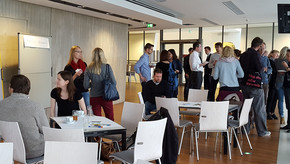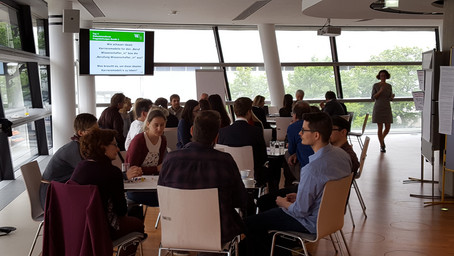Betriebsrat für das wissenschaftliche Personal
WU Employment Strategy: An Overview

Presently, a new development plan is being prepared for WU. The employment strategy of the university is a key component of the plan and thus extremely significant for the Betriebsrat (staff council).
The Betriebsrat discussed the employment strategy of the university and its own proposals at a well-attended meeting (the Betriebsversammlung) on May 9
th
.At this meeting, we gave insights into the legal context of personnel policies and showed some key data concerning the personnel structure of the academic staff at WU. As will already be clear to many academic staff, the data illustrate strong segmentation between core personnel with permanent contracts, and a large peripheral workforce with temporary contracts, or in the case of associate lecturers, with only very limited working hours.
The group of permanent staff represents less than one-third of the academic workforce, and is largely made up of professors, including associate professors. Looking at this group, the fact that some two-thirds of associate professors are over the age of 50 is important from our point of view. That means that a large portion of this group will be retiring in the foreseeable future. As a result of their long-term employment at WU, these professors have a great deal of know-how with regard to how the university works, which contributes significantly to the effective research and teaching activities of the university. Many also have responsibility for specific study modules or even entire study programs. Therefore, the Betriebsrat considers it important that the corresponding permanent positions are maintained.
In its position paper concerning the future employment strategy of WU the Betriebsrat formulates two key demands:
The WU should commit itself to career models that enable a pre-planned career and keep open the option of continuous academic employment.The guiding principles of the employment strategy should preclude hidden discriminations, particularly with regard to gender and/or age.
Over the last 15 years, temporary employment contracts have predominated. Our concern is that the forthcoming wave of retirements of Associate Professors mentioned above will most likely bring about a further shift towards temporary employment contracts.This would have negative institutional consequences. Secure and predictable career patterns are essential for achieving the excellence to which the WU aspires. Therefore, long-term contract options (in research and teaching) should be created for young academics, particularly with regard to post-doc positions. All in all, there should be an appropriate balance of temporary and permanent positions. Furthermore the dividing lines between different employment categories (e.g. prae-doc and post-doc, senior lecturer and senior scientist) should become looser.
The concrete career options of a given position should be clearly defined and communicated. Similarly, the requirements for achieving the next qualification level should be clearly defined and not subject to change.
The drafting of the development plan should be seen as an opportunity to discuss the optimum allocation of responsibilities for employment issues between the different institutional levels (Rector’s council, departments, etc.).
Generally speaking, forms of precarious employment should be avoided. This is particularly an issue in teaching contracts.

Betriebsversammlung May 9th, 2017
Coming back to the personnel structure, the current situation for workers with temporary contracts is outlined below.
Teaching and research associates (UniversitätsassistentInnen) are engaged in both research and teaching at WU, while also completing their doctoral or PhD degrees. These so called "prae-doc" positions generally comprise 30 working hours per week. Only 10% of prae-docs work fewer hours than this, which means that the fragmentation among teaching and research associates is limited. However, we wonder if full-time employment wouldn’t be more appropriate than the 30-hour contracts currently offered to most members of this group.
Approximately 90% of the university assistant positions are temporary, and a continuation from prae-doc to post-doc positions is generally no longer possible. This results in the following problem: even exceptionally skilled doctoral candidates are not retained by WU. It would surely be more desirable to retain at least a portion of highly qualified PhD and doctoral students in-house through a more flexible policy allowing prae-docs to move on to post-doc contracts.
The lack of any prospects to stay at WU and enter into a post-doctoral contract is naturally a demotivating factor for many prae-docs, especially for those for whom a continuation of their academic careers abroad is not tenable for familial or other reasons. Many end up leaving academia altogether, or making do with switching from one research project to the next while possibly also lecturing on the side.
There are also positions at WU for specialised teaching or research roles. The number of senior scientists which are research posts is only slightly smaller than the number of professors (including associate professors), but the incidence of part-time employment among senior scientists is higher. Since most senior scientists are funded through third parties, they also overwhelmingly have temporary contracts (~ 90% are temporary).
Lecturers and tutors make up a great number of those employed by WU. Including senior lecturers, this group accounts for 879 of 1635 academic employees – that is, 53.7%. In general, their working hours and duration of employment are low, with the exception of senior lecturers, of whom about one-half have permanent contracts. Nonetheless, in sum, only 4% of employees specialized in teaching have permanent contracts. This is extremely low. The kind of internal expertise that comes from long-term employment is of great relevance to the standard of teaching at the WU. It is therefore the position of the Betriebsrat that the number of permanently employed senior lecturers should be increased.
From our analysis of the employment structure at WU, the Betriebsrat concludes that a main priority should be to increase the percentage of permanently employed core personnel in order to build up internal expertise. This would also serve to offset the loss of core personnel who are expected to retire in the coming years.
The discussion at last week's meeting highlighted another aspect we should not ignore in debating WU's personnel policy. An overwhelming majoity of the participants said they had taken their academic post because they are intellectually curious and interested in new methods and debates. Indeed, some of them mentioned that “love” or “passion” for their profession is what motivates them. At the same time however, many of them pointed out that the rigid inflexible career models and employment strategies are eroding their motivation because they are more and more occupied with frustrating issues like individual working contracts, securing external financing, and so on. This should perhaps be seen as a warning that we should be thinking in future about more innovative career models--- indeed, new kinds of life-cycle career models with different core areas could be one key to opening up continuous employment in our field.
